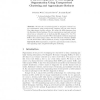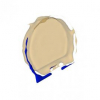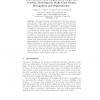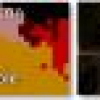COLING
2010
13 years 9 months ago
2010
Adaptor grammars are a framework for expressing and performing inference over a variety of non-parametric linguistic models. These models currently provide state-of-the-art perfor...
CCIA
2010
Springer
13 years 9 months ago
2010
Springer
In this paper, we propose an object segmentation framework, based on the popular bag of features (BoF), which can process several images per second while achieving a good segmentat...
ISVC
2010
Springer
14 years 1 months ago
2010
Springer
Abstract. We have performed segmentation procedures on a large number of images from two mammalian cell lines that were seeded at low density, in order to study trends in the segme...
EACL
2003
ACL Anthology
14 years 4 months ago
2003
ACL Anthology
In this paper we introduce a dynamic programming algorithm to perform linear text segmentation by global minimization of a segmentation cost function which consists of: (a) within...
ACL
2006
14 years 4 months ago
2006
We consider the task of unsupervised lecture segmentation. We formalize segmentation as a graph-partitioning task that optimizes the normalized cut criterion. Our approach moves b...
3DIM
2003
IEEE
14 years 8 months ago
2003
IEEE
Due to their general and robust formulation deformable models offer a very appealing approach to 3D image segmentation. However there is a trade-off between model genericity, mode...
RSFDGRC
2005
Springer
14 years 8 months ago
2005
Springer
Abstract. We introduce a hybrid approach to magnetic resonance image segmentation using unsupervised clustering and the rules derived from approximate decision reducts. We utilize ...
ICIP
2009
IEEE
15 years 3 months ago
2009
IEEE
We present a 3D segmentation technique of trabecular (cancellous) bones in CT images of Vertebral bodies (VBs). In order to be used for Bone Mineral Density (BMD) measurements, th...
ECCV
2006
Springer
15 years 4 months ago
2006
Springer
Abstract. This paper proposes a new approach to learning a discriminative model of object classes, incorporating appearance, shape and context information efficiently. The learned ...
CVPR
2008
IEEE
15 years 4 months ago
2008
IEEE
We propose semantic texton forests, efficient and powerful new low-level features. These are ensembles of decision trees that act directly on image pixels, and therefore do not ne...




